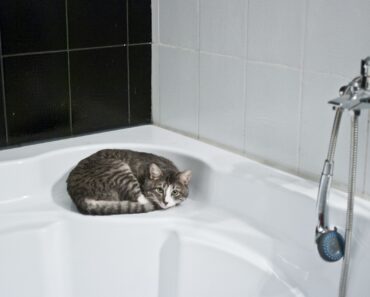
Cat and cat owners wonder how often their pets should be bathed over a period of time. Owners’ opinions differ. Some of them think that bathing domestic cats is not necessary at all, because these animals like to keep their coats clean and do not need extra care, and they do not like water. They believe in helping pets maintain their hygiene. But there is a middle ground.
Is it possible to go without a bath?
Cats have an inherent fear of water, so bathing them frequently is stressful for them. They have a coarse tongue that allows them to rub their coats gently and they can rub hard-to-reach areas with their paws. Despite this, even domestic cats need to be bathed and there are several reasons for this:
- Seasonal shedding is when an animal sheds a lot of its coat;
- Unexpected soiling that greatly affects the cat’s comfort or appearance;
- The cat has been infected by a parasite.
In the case of shedding, the hair ingested by the animal can cause an intestinal obstruction. But it cannot be said that bathing the cat will prevent such a problem. The best thing is not to neglect to comb the hair with a furminator, a special comb for cats. This will ensure the safety of the physical and mental health of your cat.
If an animal has caught parasites, you can’t rely on its natural cleanliness. In this situation, you need human help. Unwanted inhabitants on the cat’s body will cause more discomfort than water.
A cat soiled with mud, paint or similar substances can clean itself, but it is not always safe. Some of the substances in which a cat soils itself are hazardous to its health. By licking, the cat swallows the dirt, which can lead to poisoning, intestinal disease or other unpleasant consequences. Therefore, if your furry friend gets his feet caught in something, you should first check to see if he is in danger of getting hurt. If it does, you should give the cat a bath right away. When everything is not so bad, you can let the cat take care of its own personal hygiene.
How often should the cat be bathed?
Once you’ve decided how often your cat should be bathed, you need to decide: how often should the cat be bathed? Pets that participate in shows and competitions are often bathed because they always have to look their best. But the situation is different when it comes to bathing an ordinary cat that never leaves its home. You should not force a cat to take a bath every week. This can have a negative effect not only on their mental health, but also on their physical health. The surface of the cat’s fur is covered with a special grease that protects the animal from various diseases. Washing off the grease will have unpleasant consequences.
How often a pet needs a bath depends on the following criteria:
- whether the cat is an indoor or outdoor cat;
- the breed of cat, the color of its coat;
- the age of the cat;
- the presence of parasites or diseases.
An outdoor cat differs from a domestic cat in that it is more likely to find contamination. These animals only need to be bathed every 1 to 2 months. There are sometimes exceptions, such as daily washing of the paws and, if necessary, of certain parts of the body that may be soiled by your four-legged friend. Remember also that cats do not like water, precisely because their fur absorbs liquids and they are cold. To keep your pet healthy, it’s best to make sure it’s not exposed to drafts after washing, and certainly not running around outside.
Dark-colored cats do not need to be washed frequently. They simply do not show certain dirt. Also, if the cat has long hair, it is best to use a hair dryer to remove tangles. If your cat has a light coat, you should not give it too many baths. A dry brushing of the dirty part of the hair is sufficient. Sphynx cats, on the other hand, love water and even like to bathe. You’ll need to bathe them much more frequently – once every 2 or 3 weeks.
The older an animal is, the more stressed it is and the more susceptible it is to disease, so the frequency of bathing should be increased.
A pet infested with parasites will need to go through the bathing process and perhaps more than once. An infested pet should be bathed with special flea shampoos. These are available in veterinary stores, and it is advisable to consult a veterinarian before using them.
When is bathing contraindicated?
While it’s important to help your cat maintain personal hygiene, there are exceptions to this rule, in which you may need to delay bathing your furry friend. This can happen if a cat has recently been vaccinated or has had surgery.
In the case of vaccinations, you won’t have to wait long. In the case of surgery, the vet will tell you how long it will take to bathe the cat. The problem is getting water on fresh stitches. This can lead to a number of unpleasant, even life-threatening consequences. Even if the scaling, stitches and gaps in the cat’s body spoil its appearance, it is best to be patient and keep the cat healthy.
It is not necessary to bathe a cat that has just arrived home. A pet acclimates and is unlikely to develop trust in an owner who makes it uncomfortable immediately after it is admitted. In addition, the new territory will already be a stressful experience for the pet. There is no need to give him another reason to worry.
If a cat is expecting to breed, it is best to postpone bathing until after the babies are born. Bathing can be very stressful for your cat, which can have a negative impact on her health and that of her kittens. After giving birth, there’s no need to rush either. The mother cat spends all her time caring for her offspring, and an attempt to separate her from her children may constitute a loss of trust in her owner.
It is also not advisable to bathe baby cats under four months of age. They have more difficulty with water and sudden changes in conditions and temperature. Kittens are more playful than adults and may seem to need more frequent washing. But this is absolutely not the case!
Bathing procedure and some quick washing tips
The biggest questions arise when it comes directly to bathing the cat. For starters, you need to be prepared for your cat’s negative reaction to the water. Also, if possible, get help, as you probably won’t be able to do it alone. It’s a good idea to pet the cat before the bath and build up its confidence. This does not guarantee that the cat will be completely calm, but it will at least make it feel less anxious.
Never underestimate a cat’s body temperature. Their body temperature is higher than humans, so the bath water should be warmer, but not too hot. The recommended temperature is 35-39°C. This is important because sudden changes in temperature not only cause stress, but also make your cat vulnerable to disease.
In addition to the cat, the owner must also prepare. It is important to have a clean, dry towel to wrap the cat in, a special comb and, if necessary, a hair dryer, although it is not advisable to use one. In addition to this equipment, it is important to make sure that no doors are open. There should be no drafts, as cats are very delicate animals, and they are sensitive to cold.
Also be careful when choosing a shampoo. Of course, no human shampoos should be used under any circumstances. They dry out the skin and cause itching. Veterinary stores have a wide selection of shampoos for cats of different breeds and ages. There is also a separate type of shampoo for pets with fleas or other parasites.
Never try to wash your pet’s nose or ears under the faucet or shower. If water gets into the ear canals, it can lead to deafness and even more serious consequences. Muzzles can be cleaned with a damp cloth or absorbent cotton soaked in water. This will suffice.
Cats are most often washed in a bathtub, but you can also pour water into a separate container. Priority is always given to the larger ones because the water cools down more slowly. When a pet is immersed in water and starts to panic, you should never restrain it or use physical force. On the one hand, this will only provoke the cat, and on the other hand, its trust in its owner will disappear.
Some tips for washing cats:
- To prevent your pet from slipping on a surface, a soft towel or rubber mat should be used, which will give the cat a sense of security.
- The owner should be calm before bathing, as cats are sensitive to and perceive their mood.
- It’s best to wash the animal from head to tail, using gentle, even strokes.
- Avoid ruffling the hair, as this can cause tangles.
If you are afraid to bathe your dog, you can use a dry pet shampoo. You can buy it at any veterinary store.
Bathing is an important part of caring for your four-legged friend. It is important to find the right balance. Over time, every owner will remember and calculate in their head how often to bathe cats, what they need for it, and what tips to use. The most important thing is to remember to love your cat, not to make him suffer, and to make everything comfortable for him during the bath. There is no need to abuse water procedures, so pets, and their owners, will live in harmony with each other!






